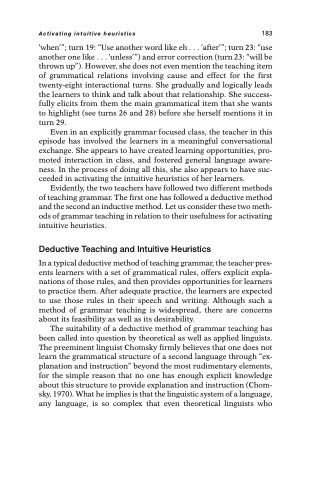Page 195 - Beyond Methods
P. 195
Activating intuitive heuristics 183
‘when’”; turn 19: “Use another word like eh . . . ‘after’”; turn 23: “use another one like . . . ‘unless’ ”) and error correction (turn 23: “will be thrown up”). However, she does not even mention the teaching item of grammatical relations involving cause and effect for the first twenty-eight interactional turns. She gradually and logically leads the learners to think and talk about that relationship. She success- fully elicits from them the main grammatical item that she wants to highlight (see turns 26 and 28) before she herself mentions it in turn 29.
Even in an explicitly grammar focused class, the teacher in this episode has involved the learners in a meaningful conversational exchange. She appears to have created learning opportunities, pro- moted interaction in class, and fostered general language aware- ness. In the process of doing all this, she also appears to have suc- ceeded in activating the intuitive heuristics of her learners.
Evidently, the two teachers have followed two different methods of teaching grammar. The first one has followed a deductive method and the second an inductive method. Let us consider these two meth- ods of grammar teaching in relation to their usefulness for activating intuitive heuristics.
Deductive Teaching and Intuitive Heuristics
In a typical deductive method of teaching grammar, the teacher pres- ents learners with a set of grammatical rules, offers explicit expla- nations of those rules, and then provides opportunities for learners to practice them. After adequate practice, the learners are expected to use those rules in their speech and writing. Although such a method of grammar teaching is widespread, there are concerns about its feasibility as well as its desirability.
The suitability of a deductive method of grammar teaching has been called into question by theoretical as well as applied linguists. The preeminent linguist Chomsky firmly believes that one does not learn the grammatical structure of a second language through “ex- planation and instruction” beyond the most rudimentary elements, for the simple reason that no one has enough explicit knowledge about this structure to provide explanation and instruction (Chom- sky, 1970). What he implies is that the linguistic system of a language, any language, is so complex that even theoretical linguists who


